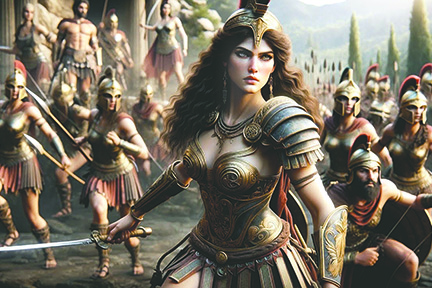
Mujeres Guerreras
Warrior Women
Cuando hablamos de guerreras nos referimos a mujeres con personalidad fuerte y valiente, que luchan por sus objetivos, por eso analizaremos a las mujeres en la literatura e historia.
En literatura el estereotipo de la mujer guerrera se inspira en la mitología griega, donde sus acciones son heroicas y épicas, para apreciar su inteligencia, estrategia y desarrollo físico.
Por supuesto debemos comenzar por las Amazonas que, según las leyendas griegas, pertenecían a una tribu de guerreras invencibles.
También debemos mencionar a la mitología británica, donde la reina Cordelia luchó en varias guerras, dirigiendo al ejército en sus batallas.
En el libro “Valentía de las Mujeres”, el historiador grecorromano Plutarco describe cómo las mujeres de Argos lucharon en contra los espartanos en el siglo quinto antes de Cristo.
En la India existen varios relatos sobre mujeres guerreras, por ejemplo, el Ramayana y el Mahabharata, escritos unos 500 años antes d Cristo, allí encontramos a Satyabhama, esposa guerrera de Krisná, que fue arquera y experta en tácticas militares, y lideró un ejército contra Narakasura, también mencionaremos a Arjuna, quien fue comandante de los ejércitos de la India.
La mitología árabe relata la vida de Hind bint Utbah quien, en el año 636, lidero la batalla de Yarmuk, luchando contra los romanos.
Los franceses idolatran a Juana de Arco, que fue una joven campesina del siglo XV, por su papel en la Guerra de los Cien Años, ya que su liderazgo en la batalla de Orleans en mayo de 1429 contribuyó a la retirada de los ingleses de la ciudad, a punto de ser canonizada como santa católica.
Guerreras en la Literatura
Las mujeres guerreras tienen una larga historia en la ficción, desde hace mucho tiempo.
“Gordafarid” es un antiguo poema épico persa, “Shāhnāmeh” es un relato épico árabe y “Camila” en la Eneida, escrita por el poeta romano Virgilio en el siglo I a.C. y “La Reina Hada” escrita por Edmund Spenser,
En China existe “La Doncella Guerrera”, sobre la heroína Hua Mulan, que se remontan a la época de las Dinastías del siglo IV, en este poema o balada, Mulan se disfraza de hombre y ocupa el lugar de su padre en la guerra para protegerlo, esta historia se popularizó gracias al largometraje Mulan, de Disney, de 1998.
También podemos sumar a las Hadas Guerreras, como la “Princesa Belle-Etoile”, cuento francés de Madame d’Aulnoy, “Costanza” cuento italiano de Giovanni Francesco Straparola, “Las tres coronas”, relato italiano de Giambattista Basile, “Ileana Simziana” cuento rumano y “Marya Morevna, la princesa guerrera” cuento ruso.
Por supuesto que, a mediados del siglo XX, comenzaron a aparecer en el cine y televisión, las mujeres guerreras, incluidas en películas de artes marciales chinas y japonesas, pero su alcance y atractivo para el público occidental es posible gracias a Marvel Studios y DC Extended Universe.
Mujer independiente
A mediados del siglo XX, hubo un cambio en el estereotipo de la protagonista femenina, en la literatura y en el cine, se reemplazó a la damisela pasiva e indefensa o la femme fatale y su opuesto la marimacha, por una mujer excepcional e independiente, que adopto el símbolo del empoderamiento femenino.
When we talk about warriors we are referring to women with strong and brave personalities, who fight for their goals, that is why we will analyze women in literature and history.
In literature, the stereotype of the female warrior is inspired by Greek mythology, where her actions are heroic and epic, to appreciate her intelligence, strategy and physical development.
Of course we must start with the Amazons who, according to Greek legends, belonged to a tribe of invincible warriors.
We must also mention British mythology, where Queen Cordelia fought in several wars, leading the army in their battles.
In the book “Bravery of Women,” Greco-Roman historian Plutarch describes how the women of Argos fought against the Spartans in the 5th century BC.
In India there are several stories about women warriors, for example, the Ramayana and the Mahabharata, written about 500 years before Christ, there we find Satyabhama, warrior wife of Krishna, who was an archer and expert in military tactics, and led an army. against Narakasura, we will also mention Arjuna, who was commander of the armies of India.
Arab mythology tells the life of Hind bint Utbah who, in the year 636, led the battle of Yarmouk, fighting against the Romans.
The French idolize Joan of Arc, who was a young peasant girl of the 15th century, for her role in the Hundred Years’ War, as her leadership in the Battle of Orleans in May 1429 contributed to the withdrawal of the English from the city, about to be canonized as a Catholic saint.
Warriors in Literature
Women warriors have a long history in fiction, going back a long time.
“Gordafarid” is an ancient Persian epic poem, “Shāhnāmeh” is an Arabic epic, and “Camilla” is the Aeneid, written by the Roman poet Virgil in the 1st century BC. and “The Fairy Queen” written by Edmund Spenser,
In China there is “The Warrior Maiden”, about the heroine Hua Mulan, which dates back to the time of the Dynasties of the 4th century, in this poem or ballad, Mulan disguises herself as a man and takes her father’s place in the war to protect him, this story was popularized thanks to Disney’s 1998 feature film Mulan.
We can also add the Warrior Fairies, such as “Princess Belle-Etoile”, a French story by Madame d’Aulnoy, “Costanza”, an Italian story by Giovanni Francesco Straparola, “The Three Crowns”, an Italian story by Giambattista Basile, “Ileana Simziana ” Romanian story and “Marya Morevna, the warrior princess” Russian story.
Of course, in the mid-20th century, female warriors began to appear in film and television, including in Chinese and Japanese martial arts films, but their reach and appeal to Western audiences is possible thanks to Marvel Studios and DC. Extended Universe.
Independent woman
In the middle of the 20th century, there was a change in the stereotype of the female protagonist, in literature and cinema, the passive and defenseless damsel or the femme fatale and its opposite the tomboy were replaced by an exceptional and independent woman, that I adopt the symbol of female empowerment.
























